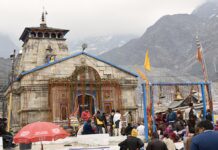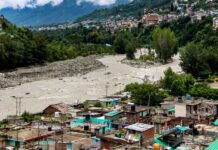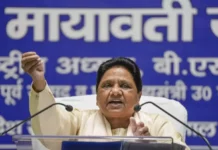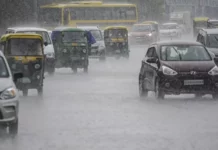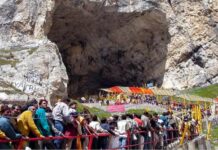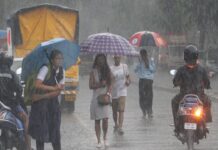 The author and his friends travel from Delhi to Himachal’s famous Kinnaur district. A blow-by-blow account of the trek in the mountains and valleys of Kinnuar.
The author and his friends travel from Delhi to Himachal’s famous Kinnaur district. A blow-by-blow account of the trek in the mountains and valleys of Kinnuar.
Despite it being Friday the thirteenth we are in high spirits as we assemble at the ISBT from where the bus for Shimla leaves. Rajat is waiting for me when I reach the bus adda. Soon Sunder arrives. But there’s no sign of Anshuman our young team leader. Our worry mainly concerns the fact that Anshuman has the rucksack that contains all the provisions for the trip. Minutes before the Himachal Roadways conductor blows the final whistle Anshuman arrives with bags on his back twice as large as him! Our foursome journey to Shimla is full of fun and banter.
Early next morning our bus journey for Kinnaur begins from Shimla’s Lakkad Bazar. It’s evening by the time the bus winds it way to Rekong Peo, a small hill town nestled below the imposing Kinnar Kailash peaks. On the way we cross Theog, Narkanda, Rampur and several small villages overhanging the swollen Sutlej, which keeps us company for most of our road journey in Kinnaur. In the mountains it’s best to travel by bus if you want to get a good view of the gorges and deep valleys. But window seats are not recommended for the weak at heart. At Rekong Peo we settle for the Snow View Hotel overlooking the market and a fascinating view of the Kinnar Kailash.
By six next morning we’re ready for last drive to Thangi a two-and-a-half hour journey 41kms away, from where our trek begins. After aloo-parantha and tea our porters and the Maruti Gypsy arrive. The road to Thangi, hugging rocky mountains above the frothy-foamy Sutlej coursing through the gorge, is simply breathtaking. There are a couple of major falls on the way. After leaving the gorges we come upon lush green mountains dotted with homes and villages. A bend in the mountains, and the Sutlej is behind us. Another hour of uphill driving we come upon a few huts along the broken road. One of them is Reena Hotel. This is Thangi.
Invisible from the road head, Thangi village is a steep ten minute climb above the road. It must be one of Himachal’s most beautiful villages, better than any picture postcard! Here, trekkers to Charang La have to get clearance from the ITBP HQs. Better still, get advance clearance from Delhi or check with the ITBP check post near the Thangi road-head. Also, ask ITBP to convey your imminent arrival to Shruting, a ten-hour uphill trek, so that the jawans there, with limited rations, are not surprised. In any case, they will extend all possible hospitality.
After Thangi the road is motorable for another three kilometers, after which there’s nothing in sight, except mountains above and a gushing river below. The trek starts as a gentle walk along the road. But soon we come to a section of dirt track where there’s hardly any space to place your feet…and down below it a steep fall over sharp rocks recently blasted off the mountain to build the road to Charang. My feet get posted at this dangerous stretch and I decide to return. Reading the fright on my face, Anshuman, who has crossed the stretch, retraces his steps, offloads my back pack takes it all with him and says, “Just hold my hand.” Thankfully someone hands me a stick and I make it across!
Behind me the scene is being repeated with Sundar who, like me, also has a mild vertigo problem. After ten minutes of nail biting suspense, we resume our journey, soon coming on a steep fall. On a trek it’s best to forget your fears and take to the mountains like a goat, or like Anshuman! Descents can be more dangerous than ascents and trekkers are advised to get a walking stick. After the frightening descent, made worse by a herd of goats hurtling down, we come to a valley of rocks and boulders along the riverbed. A few more precipitous climbs and falls later, we rest in a valley of boulders criss-crossed by several meandering streams. Taking in the beauty of the surrounding mountains we quench our thirst from ice-cold brooks and resume our journey. There are wild roses and several exotic plants and flowers along the route. Some patches look like gardens of heaven. ‘God’s own country’, whoever gave that line to Kerala hadn’t seen Kinnaur.
Lumbar
After over three hours of trekking, which included crossing the river on a trembling bridge of pine logs, we finally come upon a four-house village! This is Lumbar, at 9611 feet. A wooden hut, smelling of pinewood, is our ‘hotel’ and resting place. The quiet ‘house’ comes to life on our arrival. Hot cups of tea are served after which, while the dal-chawal gets ready, we soak our feet in the cold river flowing behind the log hut. A 15-minute rest after lunch, we begin our upward journey again.
Shruting is another 11 kilometers trek through undulating and sometimes extremely difficult terrain. You also have to brave the risk of falling rocks from loose mountainsides. The mountains here are in various stages of disintegration, some like black mounds of ash. Occasionally wild goats grazing above the mountains could inadvertently hurtle rocks and stones at you. If it’s not goats, then it’s the blasting. Our porter tells us how five Nepali laborers had lost their lives when the blasted mountainside they were working on suddenly collapsed. Their bodies were never found. There are no memorials to such men who die to make roads for us.
Shruting
The road to Shruting never seems to end. Finally, as we rest over a brook across another boulder strewn valley, the porter says, “Ab aa gaye saab, bas nadi par karna hai.” Indeed a bridge across the river was soon visible. But soon it disappeared as we took another bend in the mountains. It appeared and disappeared several times before we finally crossed the iron bridge. Shruting is a beautiful valley, glistening streams of water cutting across it. But it’s eerie. Not a soul lives here, except for six ITBP jawans. Thirty minutes of trudging through a gentle valley of shrubs and flowers we are finally able to spot the two ITBP barracks in the fading sunlight. Crossing a gurgling brook over a log bridge we are relieved to find a resting place for the night. The jawans organize food for us including the local drink and tinned tuna fish. The night is fun despite the frosty winds blowing outside. Next morning, all four nursing a hangover, we set off for Charang.
Day 2
It’s a three-and-half-hour climb from Shruting to Charang a small village tucked away in the mountains. Apparently Charang was discovered only in 1960s around the Indo-China aggression. Mid-way to Charang one gets a panoramic view of Kaza village in the hazy distance. It takes us nearly an hour before we reach Charang. Just before the gateway to Charang is a PWD guesthouse ideal for a nights stay. We unload our rucksack at the gateway and trek down to Charang crossing a rivulet on a rickety bridge. It’s a small village of wood and mud houses spread over a large area and dotted with Buddhist gomphas. Surprisingly every home here has solar panels, their only source of electricity.
From Charang we set off for Lalanti at 13000 feet. An old man advises us to halt at the dwar before Lalanti. “You’ll get plenty of wood and dung cakes to keep you warm through the night,” he assures us. The dwar is a niche in the mountains that shelters from wind and rain. The shepherds, cattle and all, often make overnight stopovers at these dwars. The trek to Lalanti La (pass) is a steep 45 degree climb. It takes us two-and-half hours of breathless climbing before we make it to Lalanti La. Anshu has a 45 minute snooze before the rest of us catch up with him. By now the terrain has become tough and treacherous.
Lalanti La gives a bird’s eye view of Charang on one side and the Kinnar Kailash peak on the other. The view takes our breath away – or whatever little is left of it! Tired, we want to pitch our tents but it is too windy, and there’s no flat patch. And Lalanti is still far away downhill. We have to negotiate a glacier that takes us half an hour. Anshu cuts steps on the hard ice. One missed step and we can slide to our deaths below. I picture my family and wonder if I’ll meet them again. Sunder has to be virtually carted across the snow and scree. Our ordeal ends as we come upon a relatively flat patch. The porters decide to cook a meal and Rajat and Anshu go scouting for a place to pitch tents. By the time they have pitched the tents our khichhdi dinner is ready…or is it lunch? We have lost track of time. The harsh terrain is littered with rocks and stones. Lachhi lights a fire with cowdung cakes retrieved from the dwar. We rest for the night. The sky is studded with stars. The moon looks forlorn. It’s a wakeful night as we are six packed into a tent for five. An unwashed, stinking Lachhi keeps rolling on to me.
Day 3
Early next morning, after tea and nature’s call, we set off for Lalanti. The air is thin now and we’re panting after ever few steps. Anshu and Rajat are way ahead of us, but they take the wrong way up a treacherous climb. An hour later they catch up with us. We still don’t appear to be anywhere near a camping site. After a few more tiring bends we are able to sight the pilgrim shelter at Lalanti. It’s nearly 1.30 in the afternoon by the time we reach it, a tin shed stinking of cow and goat shit. We pitch our tents close by. Our porters cook a meal of, you’ve guessed it, khichhidi!
Lalanti is a (relatively) green meadow where shepherds from Thangi and Charang bring their cattle to graze during monsoons. It then becomes a huge production ground of milk, ghee and cottage cheese. And festivities follow.
With the long afternoon before us we explore the bushes and rocks for flora and fauna. And guess what Anshu discovers in the distant snow, a string of humans! We take turns at the binoculars. What a relief, the first sighting of fellow humans in two days! An hour later we go up to meet the 14-member Lonely Planet (LP) team coming from Chitkul. They bring bad tidings, that the Charang La (pass) is covered with snow. The good news is that the LP team has cut steps on the snow that will make our passage easier.
Since the last lap to Chitkul will take us at least nine hours, according to the LP team, we sleep early so that we can set off early next morning. By evening the weather packs up, becomes cloudy and damp, it starts drizzling copiously. The night passes off uneventfully.
Day 4
We set off early in the wet soggy morning. The terrain is full of rocks and boulders but, thankfully, it’s not steep. After crossing the river and a final bend we come upon the dazzling Kinnar Kailash peaks! But soon the clouds mar our view. The drizzle turns into snowing! We move on, every step forward a Himalayan effort. We rest every few minutes. The journey seems endless as we go up and down the soggy, snowy features. Not a blade of grass grows here. Our shoes get caught is small crevices. And we’re not even wearing snow boots! Weary of the journey even Anshuman, our young team leader, falls sick and throws up. Sundar and I are lagging behind. It’s about 4.30 pm when we reach the base of Charang La. Rajat, the only one to hold on, eggs us on to move fast and cross the pass before it gets dark. The most difficult part of the trek is facing us. A half-kilometer perpendicular (65 degree) stretch of snow!
I have half a mind to run back to the LP team. It was only the fear of returning alone that forces me to take the climb. We crawl on all fours. It takes us over an hour to make it across to Charang La, 17,320 feet. We’re tired, but happy to be alive. Yet there’s no respite. The cloud cover is so thick we cannot see ahead. And it’s almost evening. Rajat and Chootu take the lead, sliding down the snow on their butts. The rest of us follow suit, except Sundar who got stuck at the top. Finally the two porters are dispatched up to bring him down. It’s already dark and we have no choice but to pitch our tents in the ice itself, unsure if the area is stable. This is an extra night we hadn’t foreseen! Even our rations are over. The air is so thin we can barely breathe inside the tent. We take turns unzipping the tent for fresh cold air. All of us kept awake with prayers on our lips that we should not slide down the glacier.
Day 5
With the morning light our fears evaporate. The landscape is all white, it having snowed all night. Our tents and rucksack are all wet and soggy. The drinking water and cooking gas are exhausted. So with ‘breakfast’ of snow and Glucon C we set off downhill on our last lap to Chitkul. After what seems an endless downhill trek we are delighted to meet a shepherd from Chitkul. It’s nearly evening. “How far is Chitkul, we ask impatiently. “Babuji, just ten minutes,” the shepherd’s answer delights us. But even after an hour there’s no sign of Chitkul. The terrain is still very steep. But the air is no longer thin and we take in lungs full of air. About half an hour later we come upon a gushing stream straddled by hundreds of wooden houses. This is Chitkul. Even with the fading light and our tired senses we can see she’s beautiful perched on the upper reaches of a valley of rolling greens. The mountain stream cutting across Chitkul and the meadow finally falls into the river Baspa. Beyond this last human habitation is the dirt road that leads to Tibet some 40 kms away. Only the ITBP and their mules are allowed to venture beyond.
Ashim Choudhury
(Ashim Choudhury is author of ‘The Sergeant’s Son’. He can be reached at ashimch@yahoo.com visit his blog ashimch13.blogspot.in)

